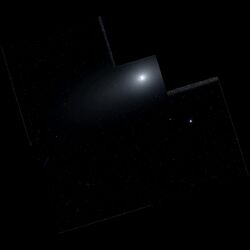Astronomy:NGC 1332
| NGC 1332 | |
|---|---|
 Hubble Space Telescope image of NGC 1332 | |
| Observation data (J2000 epoch) | |
| Constellation | Eridanus |
| Right ascension | 03h 26.170m[1] |
| Declination | −21° 20′[1] |
| Helio radial velocity | 1553 ± 19 km/s |
| Distance | 21.5 Mpc (70.1 Mly) |
| Apparent magnitude (V) | 10.3[1] |
| Characteristics | |
| Type | E[1] |
| Apparent size (V) | 4.5′ × 1.4′[1] |
| Other designations | |
| MCG-04-09-011, PGC 12838[2] | |
NGC 1332 is an almost edge-on elliptical galaxy located in constellation of Eridanus. Situated about 70 million light years away, it is a member of the Eridanus cluster of galaxies, a cluster of about 200 galaxies. It is also the brightest member of the NGC 1332 Group. It was discovered by William Herschel on 9 December 1784.
NGC 1332 has a Hubble classification of E, which indicates it is an elliptical galaxy. It is moving away from the Milky Way at a rate of 1,553 km/s. Its size on the night sky is 4.5' x 1.4' which is proportional to its real size of 92 000 ly.[citation needed]
NGC 1332 is an early-type galaxy. Despite their name, early-type galaxies are much older than spiral galaxies, and mostly comprise old, red-colored stars. Very little star formation occurs in these galaxies; the lack of star formation in elliptical galaxies appears to start at the center and then slowly propagates outward.[3]
One supernova has been observed in NGC 1332: SN 1982E (type unknown, mag. 14).[4]
Black hole
NGC 1332 is known by its possessing a supermassive black hole at the center. In 2016, a team from United States and China used the Atacama Large Millimeter/submillimeter Array (ALMA) to collect high resolution data. They were able to measure the mass of the black hole. They determined the mass of about 660 million solar-masses with an uncertainty of just 10%. NGC 1332's black hole is the most massive black hole in the Eridanus Cluster, and it is even more massive than NGC 1399's black hole (NGC 1399 is the Fornax cluster's central galaxy).[5]
Gallery
-
Pan-STARRS image of NGC 1332
-
DSS image of NGC 1332
References
- ↑ 1.0 1.1 1.2 1.3 1.4 Dunlop, Storm (2005). Atlas of the Night Sky. Collins. ISBN 978-0-00-717223-8.
- ↑ "NGC 1332". SIMBAD. Centre de données astronomiques de Strasbourg. http://simbad.u-strasbg.fr/simbad/sim-basic?Ident=NGC+1332.
- ↑ "Colossal Ancient Galaxies Die from the Inside Out". 2015. http://www.space.com/29123-ancient-galaxies-die-inside-out.html.
- ↑ Transient Name Server entry for SN 1982E. Retrieved 29 March 2023.
- ↑ Prostak, Sergio (May 6, 2016). "Scientists Determine Mass of NGC 1332’s Supermassive Black Hole | Astronomy | Sci-News.com". https://www.sci.news/astronomy/mass-ngc-1332-supermassive-black-hole-03843.html.
External links
 |


